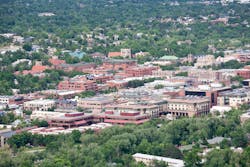Boulder, Colorado, U.S., is a lot like many American cities today. The community, nestled at the foothills of the Rocky Mountains, is committed to making real reductions in its carbon emissions and maximizing the use of renewable energy.
In October, the Intergovernmental Panel on Climate Change released its most dramatic report yet. In November, the federal government released an updated Climate Assessment, tallying billions in potential costs related to climate change. The message from these two reports is clear: Now is the time to act on climate. According to the report, all communities need to break records for emissions reductions every year through 2030 to stave off drastic environmental changes. As the home to dozens of world-class climate scientists, this is something Boulder deeply understands.
The Boulder community has made a strong commitment to addressing climate change, and the city’s all-of-the-above approach has made significant progress. Boulder’s emissions are down nearly 16% since 2005. However, Boulder’s analysis shows that energy efficiency, improvements to transportation and access to recycling and compost by themselves won’t achieve the emissions reductions required.
The path to deep carbon reduction for Boulder? Run the electric utility yourself and control the source of your power.
Why Create a City-Run Utility?
Getting to 100% renewables and reducing greenhouse gas emissions 80% aren’t just lofty goals. For Boulder, especially in light of the most recent IPCC report, they’re the keys to a resilient and livable future. That’s why dedicated community members and city staff came together to explore a new approach—one that permits the city to decide for itself the source of its power. The city’s local power effort was born.
In Boulder, electricity use makes up half of all the community’s emissions. Reducing those emissions and meeting the city’s stringent targets means attacking the main source:
electricity. But under Colorado law, communities cannot choose what sources their investor-owned utilities use to generate electricity.
After numerous attempts to work with its IOU to speed up the greening of its electricity, the city decided to chart a path toward operating its own electric utility. As a retail utility, the city would be able to purchase power from wholesale suppliers and the city’s power supply could better reflect the community’s values, especially action on climate issues.
Climate Action and Other Goals
This effort has never been about climate alone; it also focuses on the benefits of resilience and economic vitality. When it comes to local control, Boulder is privileged with a highly engaged community that is quick to participate in community decisions, big and small, from questions of utility governance to resource procurement to demand-side management program design. The community is equipped to participate in its utility’s resource planning and help design programs and services that fit their needs.
Affordable rates and reliability also rank high among the city’s goals. Boulder is home to the flagship University of Colorado campus, various federal labs and large tech and drug companies. Improving the reliability of the system is essential to preserving the community’s long-term economic vitality.
What’s Next
In September 2017, the city’s application to separate from the IOU’s electric system won conditional approval from state regulators. In December 2018, Boulder’s city council approved moving forward with the process to purchase the existing electric infrastructure.
The acquisition, which may include condemnation, will lead the city to one of several significant cost estimates. In addition to the cost of the assets, the city must determine construction costs, power supply and other start-up costs to determine whether the project is financially feasible.
These numbers aren’t just needed for the city council. For this effort, the community will ultimately make the final decision. In 2020, after the city receives a clear picture of the costs and benefits, the citizens will vote whether to move forward. They have the power to decide.
Community decision-making will play a role beyond simply voting. Standing up to a utility is a significant undertaking, and the city is getting a head start by beginning to set policies and programs now. Deliberations with the community, supported by university researchers, as well as sessions designed to bring a wide and representative sample of the community together, are important components of the communication and engagement plan for this phase.
National Attention
Access to more renewable resources is key to achieving the city’s emissions reduction goals. The path the city has chosen, while unprecedented in recent history in Colorado, opens new opportunities. Boulder’s exploration of this frontier is attracting interest nationally and, notably, from other Colorado towns like Pueblo that share similar environmental and affordability goals and want more community control. Follow along with the city’s efforts on its website, BoulderColorado.gov/Local-Power.
About the Author
Steve Catanach
Steve Catanach is the Director of Climate Initiatives for the city of Boulder. The department manages Boulder’s development of a local electric utility and other energy initiatives, as well as the city’s climate, sustainability and resilience programs
